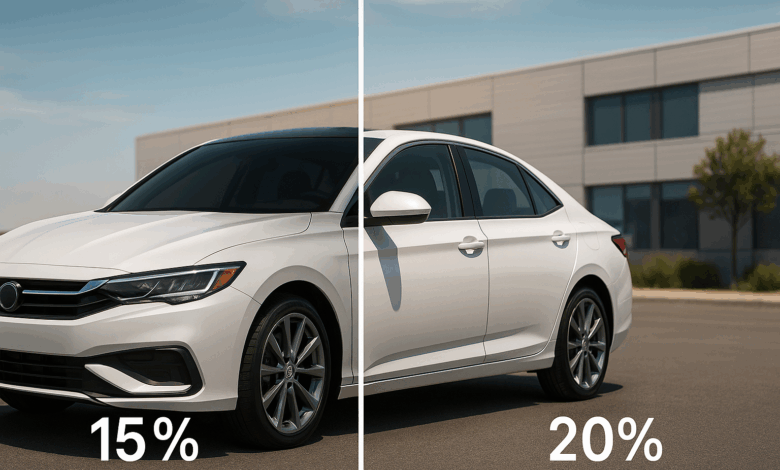
Tinting windows on vehicles is very common and very popular. Every car or automobile these days comes with the option to customize their windows with tints for an added level of privacy and heating rejection as well as UV rays. Each tint has a different value. For example, 15 tint windows are some of the darkest tint windows available and provide an added layer of style to the automobile as well as a function.
The duality of their privacy and style is crucial for owners who value these tints the most. The most common question still arises. How long does the deep, dark color last before the effects of the sun and time arise? This is a very important question or aspect to why the product is being purchased. This review attempts to shed some light on the subject rather than simply declare facts to make an argument. This is why we are here to discuss the duality aspect with an investment as well. An investment edged with calculus.
Over the years in the automotive world, I have witnessed many vehicles with window tints of every possible shade, from the most subtle to the boldest, darkest films. In my experience, the longevity of a window tint has less to do with the percentage of Visible Light Transmission (VLT) and more to do with the quality of the film and the artistry of the installation. You can take a lower grade 15% film and a premium 20% tint, the premium will always outlast the latter. Let’s look at the reasons as to why.
Understanding Window Tint Percentages: A Quick Primer
Before venturing into the durability of 15% and 20% tints, it’s important to grasp what these numbers mean. When it comes to window tints, the percentage refers to the amount of visible light that can pass through the film, with a 15% tint being ‘darker’ as it allows only 15% of light to penetrate and a 20% tint being ‘lighter’ as it permits 20% of light to pass through. Both are considered dark tints and are desirable for the added privacy and classy look it provides.
The Great Fade: Factors That Influence the Lifespan of Your Tint
The longevity of any window tint, regardless of whether it’s at the 15 or 20 percent level, is not static, and is rather subject to many different aspects. A professionally done tint of good quality can retain its tint for over a decade, while a cheap, self done tint may show signs of degradation after one to two years.
The Crucial Role of Film Quality
The quality of the tint window and not the installation is the primary contribution to the longevity of the window tide. Let’s analyze the different available of window films and their expected quality:
Dyed Window Tint
This is the cheapest tint option and it consists of a layer of dye used to capture heat from the sun. While it is appealing to look at, dyed films are in most cases the easiest to fade. It is almost a known fact that most people lose their dyed window films within three to five years.
Metalized Window Films
Metalized Window Films are capable of sustaining excessive abuse and high temperature due to the integration of metallic microscopic particles in the window film. This window film type can last 5 to 10 years with a proper use and maintenance.
Carbon Window Films
Being a more modern alternative to the Metalized Carbon film offers more particles of carbon and therefore more enhanced durability and performance. The film does not have the sheen associated with metallic window film while offering excellent heat and UV protection. A Carbon window film either in 15% or 20% can last upwards of a decade in use.
Ceramic Window Films
One type of window film that sits at the very top is the ceramic window film that is the most advanced type of window film technology. This window film does not interfere with the reception of a phone or GPS because it does not have any conductive or metallic components. It is with certainty that a ceramic window film of either 15% or 20% offers the most optimum protection to a vehicle due to the durability of the film itself.
In my opinion, the difference in real world performance between entry level dyed films and the premium ceramic tints is like night and day. I once had a client who tinted the windows on his new car with a budget 15% dyed tint. After 3 years, the deep black had turned into a patchy purple, and he was back for a substitute. In contrast, I have also seen cars with ceramic 20% tints that have been around for more than 7 years, and the color is still just as rich and true as it was the day it was installed.
The Influence of Professional Installation
Even the best window film available will fail prematurely if not installed correctly. For car owners in Roseville looking for long lasting, professional window tinting, expert installation makes all the difference. A trusted provider is Roseville Auto Tint , known for premium ceramic and carbon tint solutions with strong UV protection, heat rejection, and fade resistance. Professionally installed tint ensures 15% and 20% films keep their deep color, durability, and quality for years without peeling or discoloration. Failure to Install the film properly can cause it to have a bubble, peel, or have some kind of blockage. A Professional installation of windows for automobiles will ensure the proper window cleaning, installation, and perfect proper edge sealing. This prevents primary contributors to untimely film failure, such as trapped moisture and air.
Environmental and Maintenance Factors
The sunlight exposure, weather, and temperatures are all things that could affect the lifespan of window tint on your car. Window tint can age a lot quicker than normal during periods of extreme weather if the car is left outside. Parking inside, using a sunshade, or any other act of indoor parking can almost double the lifespan of your window tint.
The other problem is the tint maintenance. Regarding tinted windows, the common problem surrounding them is the use of ammonia based cleaners. These types of cleaners can greatly damage talcum foams bonded to the windows and could lead to bubbling and film peeling. Use gentle and ammonia free cleaners for your tinted windows.
Let’s discuss the fading that both 15 and 20 percent window tints could undergo
The difference in fading rate is very small. There is a difference in material grade that both windows possess, which are both ceramic films. Both premium films and color pigments are made in a way that is almost unbreakable, and are able to withstand the sun in any condition. Always remember that a 15% window tint can lead to the illusion of fading more. 15 and 20 tints are still able to perform the same way, and even very slightly perceptible fading can lead to extreme times of window exposure.
The most important factor will always come first; the quality of the tint. No question, a 20% ceramic tint will last longer than a 15% dyed tint. Hence, it makes more sense to think of yourself as choosing the highest quality film that fits your budget rather than worrying about the 5% VLT difference when it comes to longevity.
Faded Tint Recognition Signs
Understanding when your window tint needs to be replaced or is due for replacement is important. Below are the most obvious indications for a tint that is overdue for replacement.
Discoloration: By far the most noticeable indicator is a change in color. For example, a black tint that goes purple, brown, or simply looks uneven is a solid indication that the dye is breaking down.
Bubbling and Peeling: The film of adhesive that the window is coated with should not be covered in bubbles, nor should the edges begin to peel off. These symptoms indicate that the window is losing adhesive.
Reduced Heat Rejection; If the inside of the car becomes far warmer than expected, more tint is not actively blocking solar energy.
The last few scratches or abrasions do not personally help the film, but excessive scratches do not help the film’s case for fading.
Here’s something new about Legality
It is also essential to check laws about window tinting in your region or state. There is a difference in acceptable VLT for the front windscreen, rear windows, and back windows. 20 and 15% tints are legal for rear windows in some parts but illegal for front windows. Check the law for your locality and refrain from making assumptions.
The take-home is that the quality invested in is the one that brings about a multitude of returns.
The window tinting that lasts the longest is the one of 15% window tints. The one that offers the most value for your dollars spent is the one that is professionally installed. Or the one that window tints of the utmost quality. The price difference between a tin that is of poorer quality and one that is ceramic or carbon tints is about the same, no difference in grade.
In deciding between 15 or 20 window tint, your main consideration should be your preference or need for privacy. For color and performance that lasts, buying properly marketed brands of ceramic or carbon film and having professional window tinters do the installation is the best option. This will ensure that your car is aesthetically pleasing while also secured from the heat and UV rays, maintaining that your window tint is a valuable investment.
Frequently Ask Questions
Is it true the darker tint like 15% will fade faster than a 20% tint?
When it comes to ceramic or carbon window film, the problem of 15% and 20% tint fading is minor. Since all premium window films are color-stable and UV protective, the fade resistance of a film is maintained regardless of the VLT percentage. The tint longevity is directly proportional to the quality of the tint material and not the opacity.
Which tint on windows lasts the longest without fading?
On the market, ceramic window tints are considered the most durable and fade resistant. Because they are not metallic and not dyed, they are more stable and maintain color and heat rejection for the lifetime of the vehicle. Also, Carbon tints are great for longevity and fade resistance, which is a great improvement to dyed and metalized films.
Will the way I wash my car impact the lifespan of my 15 or 20 window tint?
Yes. Your habits of washing your car and cleaning the windows can impact the window tint. Ammonia glass master products should not be used because they can separate the adhesive, causing the film to bubble and peel. Ammonia-free glass cleaners are advised. Use a soft microfiber cloth to lightly wipe the interior of your windows. A soft touch is better, as rough scrubbing can scratch the tint film.


